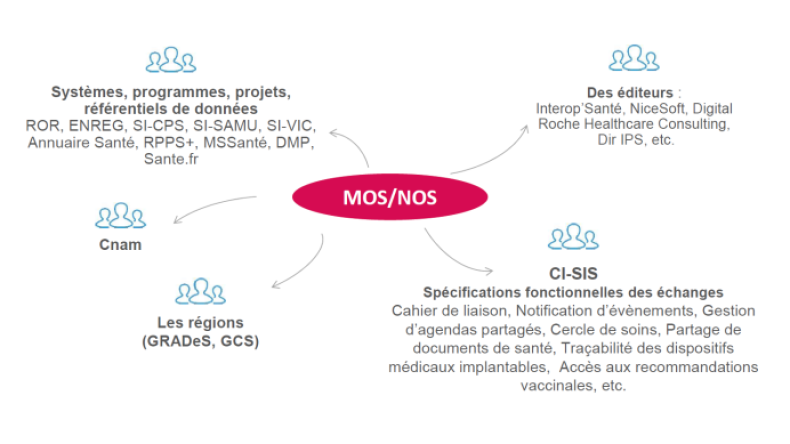Votre question concerne quel type d'offre ?
Votre question concerne quel couloir Ségur ?
Votre question concerne quel dispositif Ségur ?
Votre question concerne quel produit ou service produit?
Votre question concerne quelle thématique ?
The ANS conducted a study on telehealth in France, based on 14 practices covering 11 specialties. These are:
- nephrology, geriatrics, cardiology, orthopedics/traumatology, anethesia, psychiatry, gerontopsychiatry (teleconsultation practices);
- neuropediatrics, dermatology, maxillofacial surgery (tele-expertise practices);
- ophthalmology, medical and surgical neurology, tele-radiology, chronic wounds treatment (multi-act practices).
These practices are presented as fact sheets in the document below “Restitution des cas d’usage en télémédecine”
Cette réponse vous a-t-elle été utile ?
There are two steps to follow:
Step 1: Administrative phase
Should you wish to order test CPS cards or register authorisations for test software, you may:
- read our complete products offer ;
- place an order
To place an order, select your Profile and your Structure, then choose “Produits de développement. Commander des produits de développement : carte et/ou certificat logiciel de test" (Test products for products, cards and/or test software).
Step 2: Technical phase
Use the card you validated after step 1 in order to connect with the Trusted Platform IGC-Santé. You will be able to order, withdraw, monitor and revoke test certificates through the IHM or Webservice interface.
In order to do so, make sur you have inserted your test card in the card reader.
Read more about specific setup guidelines:
Cette réponse vous a-t-elle été utile ?
Health professionals are encouraged to use MOS and NOS for three main reasons :
- enhance the interoperability of information systems by harmonising names, attributes, codes and nomenclatures;
- share the same understanding of the information, regardless of which directory or reference document it is taken from;
- facilitate the specification, analysis and conception of a project.
The ANS offers training on MOS-NOS and the elaboration method for exchanges’ functional specs (see our Documentation section).
The illustration below gives you examples of the types of professionals using the MOS-NOS:

Cette réponse vous a-t-elle été utile ?
It is compulsory to have an individual CPx-type card to log in to the INSi teleservice. Three types of cards are supported: CPS, CPE, CPF.
Cette réponse vous a-t-elle été utile ?
CPx cards issued before December 2020 have a contactless chip that prevents from overwriting its code.
The new CPS R3V3 cards that are now in circulation have a Mifare Desfire chip. These cards can stock crypto-secret keys that work with the Mifare Desfire protocol.
All the information about this feature is available in the Manual to deploy contactless CPx cards (available to download below). One must be cautious about the data inserted in the chip’s writing code.
We strongly advise against using this section of the chip to stock access rights. The ANS recommends you to use the ANSSI guidelines on using a "transparent" reader in connected mode. This does not involve a cryptographic protocol during a badge authentication – only the UTL (logic treatment unit) takes part in the cryptographic protocol.
ANSSI advises against setting up a “smart” badge allowing a double authentication breaking from the UTL.
All the recommendations on securing systems for physical access and video projection are available in the document below, "Recommendations on securing systems for physical and video projection access".
Cette réponse vous a-t-elle été utile ?
The IGC-Santé is dedicated to the health sector and follows strict procedures in terms of data collection, professional identification, and works with certified authorities (RPPS register, etc.).
The certificates issued by the IGC guarantee the security of software or electronic cards, such as the CPS card.
The IGC also manages the publication of these certificates and can revoke them – this is signalled to the apps using certificates in revocation listings.
Cette réponse vous a-t-elle été utile ?
The MOS is a collection of concepts described homogeneously and neutrally in terms of technologies. It offers a common description of the information processed and exchanged in the information systems to make digital communication easier.
The overall consistency of the MOS is founded on the definition and description of its UML (Unified Modelling Language) concepts.
Some MOS concepts can be coded. They are associated with the nomenclatures of health objects (NOS), i.e. lists of codes/labels.
You are encouraged to use MOS and NOS to :
- optimise and coordinate efforts when you analyse or conceive a system (or an application) by re-using the same semantic components;
- make sure there is consistency in your internal developments and with external systems, for the best possible interoperability.
Cette réponse vous a-t-elle été utile ?
The European Commission’s studies have determined there is a need for a base vocabulary, such as MOS and NOS, which can be used as a starting point for:
- develop and evolve information systems (IS) to formalise the conceptual and logical data they utilise (for instance, the MOS is a reference for the modelling of the RPPS);
- share information between ISs to create specific models of data they can use (thus, the MOS is underlying the ROR exposure model);
- combine and synthetise elements originating from different sources;
- publish data in a common format, such as a directory or catalogue of service (for example, the Annuaire Santé / Health Pro Directory).
Cette réponse vous a-t-elle été utile ?
There are two main reasons for the creation of IGC-Santé :
- guaranteeing the security of private keys and certificates issued by the ANS: the access to these private keys must be limited in order to prevent duplicates or their installation more than one device;
- maintaining a continuity in services: many health apps used to work on certificates issued by former CKI that ceased their activity in January 2021. These apps must be compatible with certificates issued by the IGC-Santé.
In addition, these certificates meet the security standards (risk analysis, safety policies), or “Certifying Policies” that comply with the PGSS-IS guidelines.
Cette réponse vous a-t-elle été utile ?
This midware allows the interfacing between computer applications, such as the Vivoptim doctors portal and the CPS card.
Cette réponse vous a-t-elle été utile ?


